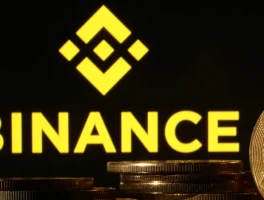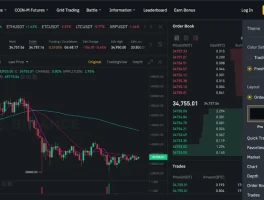The Architecture of Dominance
To understand Binance, you first have to discard the notion that it’s merely a place to trade digital assets. That’s like calling New York City a place with a few tall buildings. The platform, founded in mid-2017, has achieved a scale that functionally makes it a sovereign financial ecosystem. It is, by a staggering margin, the world’s largest cryptocurrency exchange, and the sheer gravitational pull of its trading volume creates a moat of high liquidity that competitors struggle to cross. When you log in for the first time, the screen erupts in a dizzying ballet of flashing numbers, scrolling tickers, and complex charts—it feels less like a website and more like the command deck of a starship. For the seasoned trader, this is paradise. For the novice wondering `how to buy bitcoin`, it’s an immediate and potentially overwhelming data storm.
The numbers supporting this dominance are, frankly, difficult to argue with. We're talking about a platform that supports hundreds of cryptocurrencies—over 350 by most recent counts—and a laundry list of fiat currencies from the USD to the Turkish Lira. This isn't just a marketplace; it's a global financial hub. The core of its power lies in its liquidity. For institutional and high-frequency traders, liquidity is everything. It’s the difference between executing a trade at your desired price and suffering from slippage that eats away at margins. In this arena, Binance is the undisputed king, leaving even major players like `Coinbase` in its wake.
But the trading engine is just the foundation. The true genius, or perhaps the true danger, of the Binance model is the ecosystem built on top of it. Products like Binance Earn, Launchpool, and the new Megadrop platform aren't just features; they are sophisticated capital traps designed to keep user assets within the Binance universe. Why move your crypto to a decentralized wallet to stake it when you can do it with one click on Binance Earn? Why take a risk on an unknown project’s ICO when you can get early access through the vetted Binance Launchpad? It's a masterclass in vertical integration.
And this is the part of the structure that I find genuinely fascinating from an analytical standpoint. The company’s native token, Binance Coin (BNB), isn't just a utility token for fee discounts (a 10% discount, to be precise). It’s the lifeblood of this digital city-state. The company’s policy of using 20% of its profits to buy back and burn BNB is a direct, programmatic mechanism to create deflationary pressure. I've analyzed hundreds of corporate stock buyback programs, and this is essentially a crypto-native, automated version designed to support the value of their native "currency." It’s an incredibly powerful economic lever. But what happens if those profits shrink? And how transparent is the accounting that determines that 20% figure in the first place?

Cracks in the Foundation
For all its architectural brilliance, the Binance empire shows signs of strain. The sheer complexity that makes it a paradise for power users creates a significant barrier to entry for the mainstream. This isn't just an anecdotal observation; it’s a strategic vulnerability. As the crypto market matures, the next wave of adoption won't come from users who understand order books and leveraged futures. It will come from those who want a simple, secure, and reliable experience. This is where the platform’s sprawling nature becomes a liability.
The qualitative data, gathered from user forums and social media, points to another significant stress fracture: customer support. Reports of 12-hour wait times for live chat are not outliers; they appear to be a pattern. This is a classic symptom of a company whose growth has dramatically outpaced its support infrastructure. When you’re dealing with people’s money, a slow response isn’t an inconvenience; it’s a source of genuine panic and a driver of churn. Can a financial institution of this size truly afford to treat customer service as a secondary priority?
Then there's the issue of trust and security, a question central to any Binance Review & Beginners Guide 2025: Is Binance Safe? - CryptoPotato. To their credit, after a significant security breach in 2019, Binance fully reimbursed all affected users, a move that demonstrated immense financial strength. Today, their security apparatus includes 2FA, passkeys, and a proof-of-reserves system verifiable via a Merkle Tree. This is where my methodological critique comes in. While the proof-of-reserves dashboard is a step toward transparency, it is not a substitute for a full, independent financial audit conducted by a reputable firm. It proves they hold user assets they claim to hold at a specific moment in time. It does not provide a comprehensive picture of the company's liabilities or overall financial health. It’s a snapshot, not the full film.
This brings us to the elephant in the room: regulation. The fact sheet notes that the US version of Binance is more limited, a direct consequence of navigating a stricter regulatory environment. The global entity, based in Dubai, operates in a vast grey area, available in dozens of countries with wildly different legal frameworks. This strategy of regulatory arbitrage has fueled its growth, but it’s also its single greatest point of failure. The entire kingdom is built on the assumption that it can continue to outrun or outmaneuver a globally coordinated regulatory crackdown. Is that a sustainable long-term business model, or just a ticking clock?
An Uncomfortable Equilibrium
Binance isn't a kingdom of cards, but it's not an unassailable fortress either. It exists in a state of uncomfortable equilibrium. The data shows an entity with unparalleled market depth, a fiercely loyal user base, and a brilliantly designed economic flywheel in its BNB token. Its dominance is a fact, not a marketing claim. However, its foundation rests on two precarious pillars: the tolerance of global regulators and the patience of its millions of users who must navigate its immense complexity and occasional service failings. The question isn't whether Binance is powerful today; it's whether its very architecture—built for speed and aggressive expansion—can be retrofitted for an era of compliance and mainstream adoption without collapsing under its own weight.


